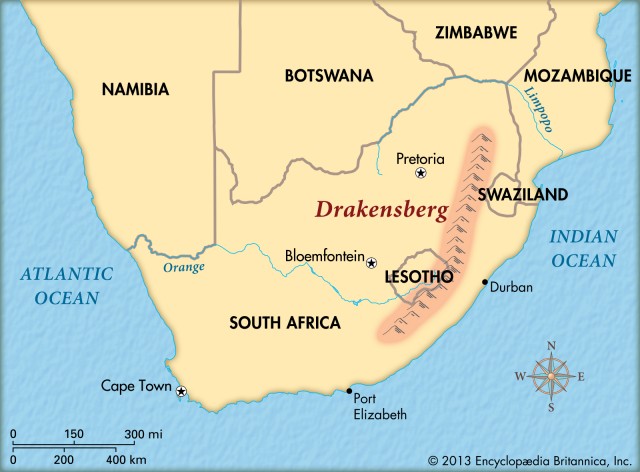Drakensberg Mountains
THE DRAKENSBERG Mountains form one of the most scenic natural areas in SOUTH AFRICA. The mountain range straddles the eastern border of LESOTHO, a LANDLOCKED nation lying within the boundaries of South Africa, located about 150 mi (250 km) northwest of Durban. The name Drakensberg means “Dragon Mountains” in Afrikaans. The range is also known to the Zulu nation as “uKhahlamba” (the “Barrier of Spears”).
The Drakensberg Mountains are the southern extension of the interior highlands of Africa, rising to 10,826 ft (3,300 m) before dropping to the coastal lowlands near Durban. The Drakensbergs serve as the headwaters of South Africa's largest river, the Orange River, which flows west from the highlands of Lesotho to the South Africa-NAMIBIA border before emptying into the ATLANTIC OCEAN. The steep gradients and land use cause many of South Africa's rivers to have a high rate of runoff and soil EROSION.

Seasonality is reflected in dry, sunny winters (April to October) and summer rains (November to March). Rainfall varies from 15.7 in (40 cm) to 35.4 in (90 cm) of precipitation per year, with some areas occasionally receiving up to 78.7 in (200 cm) per year. A “rainfall line” denotes grazing and irrigated crops to the west and land more suitable for farming to the east. Record snowfalls (19.7 in or 50 cm) occurred in July 1994.
Bushmen (called “San”) have inhabited the basalt ESCARPMENT from thousands of years ago up until the late 1800s, leaving tens of thousands of rock paintings at over 500 sites. This is a major reason part of the mountain range was designated the uKhahlamba-Drakensberg World Heritage Site in 2000 by the United Nations.
The Drakensberg Mountains also hold numerous national parks, the most scenic of which is Royal Natal National Park, located at the northern end of the range. Here lies the Amphitheatre, a natural ring of thousand-meter high cliffs that includes multilevel Thukela Falls, the second-highest waterfall in the world.
In addition to cultural and scenic amenities, the Drakensberg Mountains also harbor high levels of biodiversity, much of this resulting from the steep elevation gradients. Ninety-eight of 2,153 plant species are endemic or near-endemic to the area; the almost 300 bird species include the globally endangered cape parrot and white-winged fluff-tail.
Despite efforts by Zulu kings to limit the range of trophy hunters, several wildlife species nearly became extinct from hunting here by the late 1800s. The eland, endemic gray rhebock, and clawless and spotted-neck otters are species populations exhibiting healthy recovery from this historic setback. Other traditional African wildlife that inhabit the Drakensberg Mountains include leopard, baboon, jackal, wildebeest, and zebra.
Historic battlefields dot the region, marking sites of the British-Zulu wars and British-Boer wars of the 1800s. Nearby towns and cities include Ladysmith, through which Mahatma Gandhi and Winston Churchill passed early in their careers. Ladysmith is the home of Ladysmith Black Mambazo, a musical group popularized globally by Paul Simon.